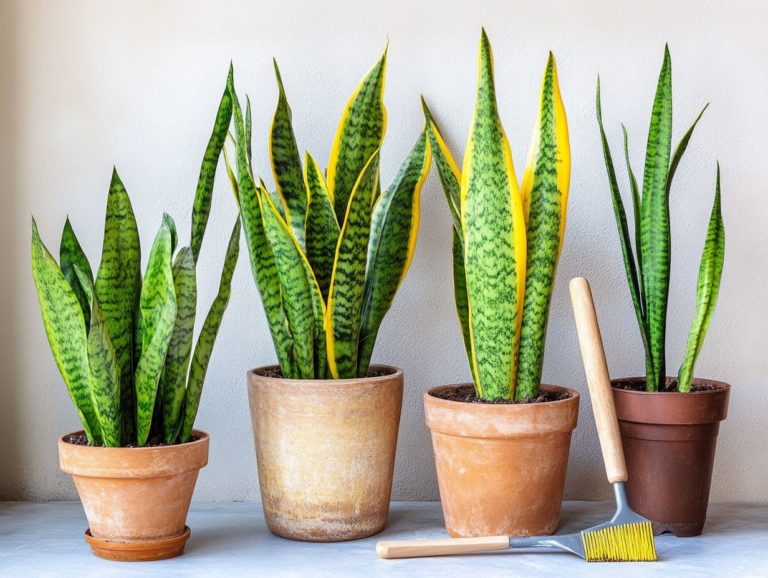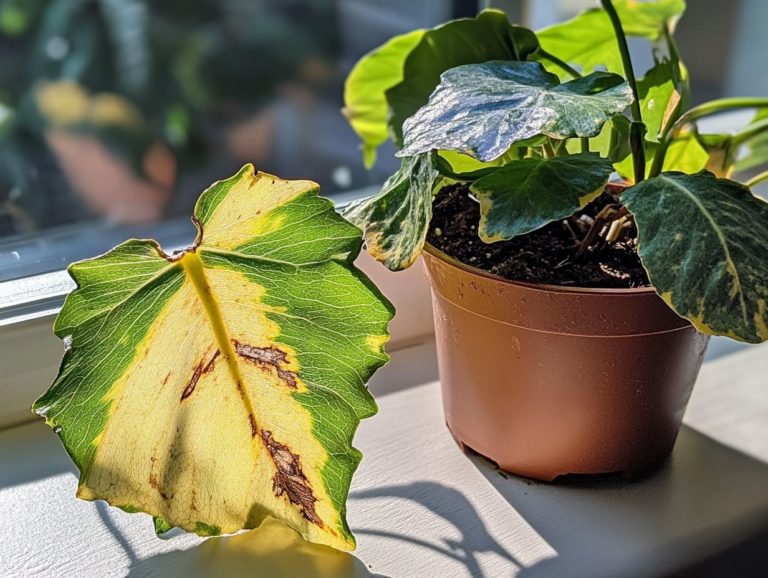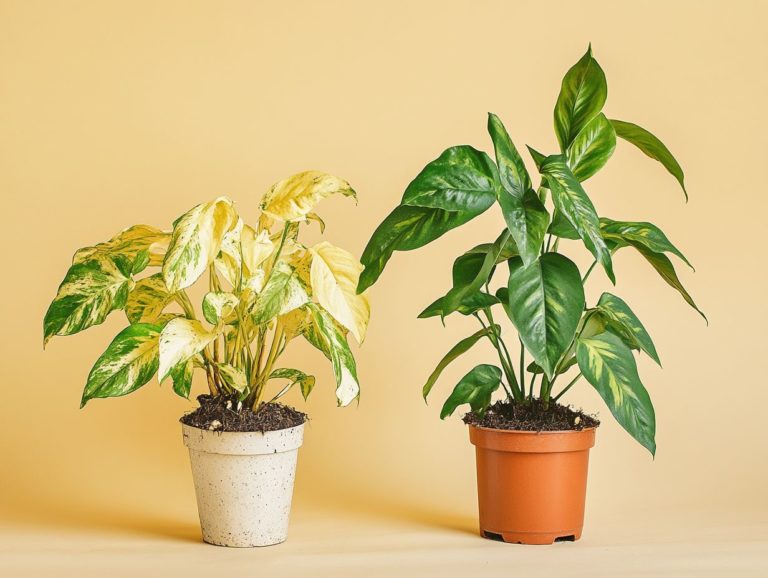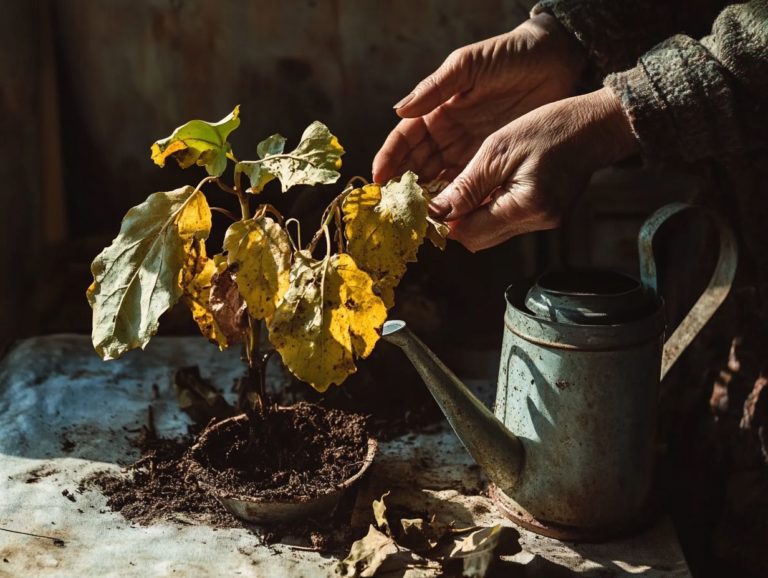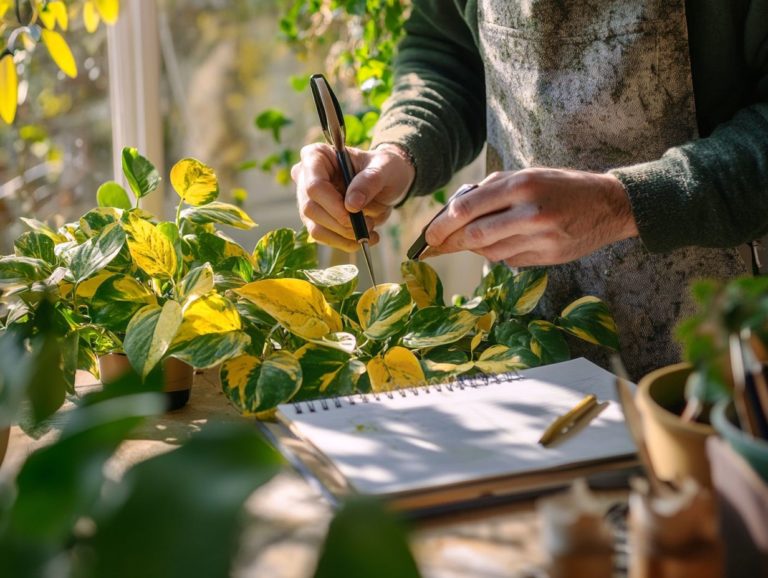5 Common Issues for Beginners in Plant Care
Caring for plants can be a truly rewarding journey. However, as a new plant parent, you might stumble upon common pitfalls that can lead to distressing outcomes.
From the delicate balance of overwatering and underwatering to the nuances of improper lighting and soil choices, these issues can easily derail your best intentions. Grasping the fundamental needs of your plants is essential for their health and vitality.
Get ready to explore five common challenges that every new plant parent faces! This article provides valuable insights and practical tips to help you cultivate a thriving indoor garden.
Immerse yourself in this guide to ensure your green companions flourish!
Contents
Key Takeaways:

- Overwatering and underwatering are common mistakes made by beginners, leading to root rot and dehydration.
- Proper lighting and soil are crucial for plant growth, with different types catering to specific plant needs.
- Understanding a plant’s basic needs and signs of distress, along with creating a consistent care routine, are key to successful plant care for beginners.
1. Overwatering
Overwatering is one of the most common challenges for houseplant enthusiasts. It often triggers a series of problems like root rot, yellowing leaves, and even tiny gnats that thrive in overly moist soil.
This prevalent issue can seriously harm the health of your indoor plants if not diagnosed and addressed promptly. When your plants receive too much water, their roots can suffocate, hindering their ability to absorb essential nutrients.
You might notice signs of overwatering such as wilting, even when the soil is soggy, and leaves taking on a distressing shade of yellow, a clear signal of stress. Don’t wait address these symptoms quickly!
Check the moisture level of the soil using your finger or a moisture meter. If the soil feels excessively soggy, it may be time to rethink your watering schedule. Allow the soil to dry out between sessions.
Additionally, improve drainage by repotting your plants in a well-draining potting mix. This can significantly enhance their growth and well-being.
2. Underwatering
Underwatering can be just as detrimental to your indoor plants as overwatering. You might notice symptoms like dry, yellowing leaves and distorted growth, clear signs that your plant isn’t getting the hydration it needs.
Along with these visual cues, pay attention to the soil; it may feel excessively dry or even pull away from the edges of the pot. To ensure your plant thrives, establish a routine for checking the moisture level regularly and consult this quick guide to common indoor plant issues for further assistance.
A moisture meter can be a game-changer, allowing you to accurately assess how dry the soil is beneath the surface. Tailor your watering schedule to the specific needs of your indoor plants; for instance, succulents typically need less frequent watering than ferns.
By implementing these practices, you can foster healthy growth and achieve vibrant foliage.
3. Lack of Proper Lighting
A lack of proper lighting can be a game-changer for your indoor plants. Insufficient sunlight might cause those lovely green leaves to yellow and lead to weak, spindly growth, ultimately diminishing their vitality.
To ensure your plants thrive, grasp the different light requirements for each species. Many tropical plants thrive in bright light, supporting photosynthesis and encouraging lush, green foliage.
You can evaluate your light conditions by observing how sunlight moves through your space during the day or using a light meter for a more accurate assessment. If certain areas lack brightness, consider repositioning your plants closer to windows or incorporating artificial grow lights.
These adjustments can significantly boost their growth and contribute to a more vibrant indoor atmosphere, not to mention a healthier plant collection.
4. Not Choosing the Right Soil
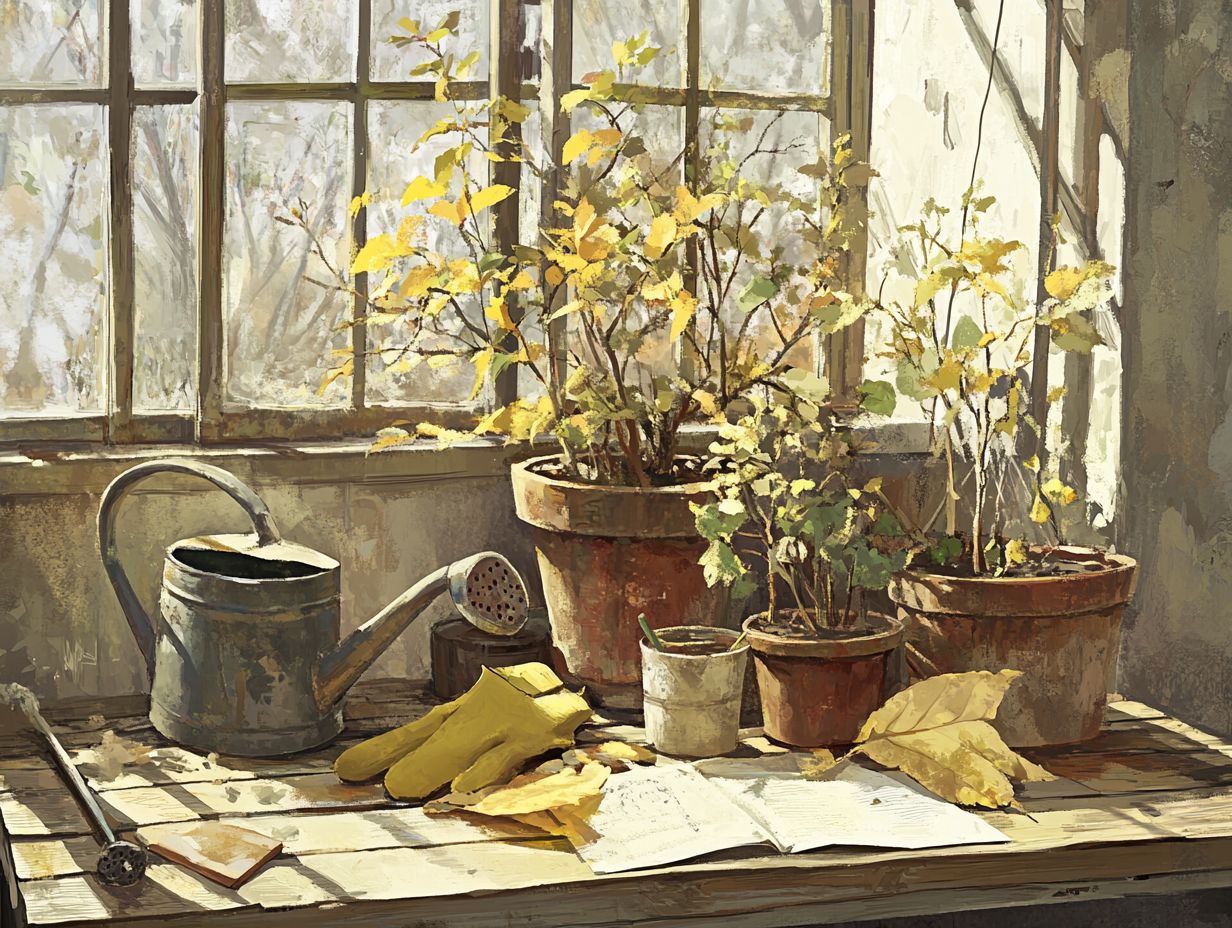
Choosing the right soil is crucial for the health of your indoor plants. Using the wrong type can lead to root rot, poor drainage, and nutrient deficiencies. These issues can stifle growth and vitality.
The ideal potting soil anchors the roots while allowing for proper air circulation and water retention. This balance is essential for your indoor greenery to flourish. There are various potting mixes available, each tailored to meet the specific needs of tropical plants, succulents, and cacti. Each type requires its unique balance of drainage and aeration.
A well-balanced mix can make the difference between lush, vibrant foliage and sad, lackluster growth.
Thinking about improving your soil? Adding perlite can boost drainage, while worm castings provide a nutrient boost. Understanding the water and light requirements for each plant will help refine your soil choice, ensuring that your green friends thrive.
5. Not Understanding Plant Needs
Understanding the specific needs of your indoor plants is vital for their growth and longevity. Factors like humidity, sunlight, and proper watering practices dramatically influence their health and resilience against diseases and pests.
To ensure that each plant species thrives, pay attention to humidity levels. Aim to replicate their natural habitats. For instance, tropical plants thrive in higher humidity; consider misting them or using a pebble tray to create an ideal environment. Additionally, be mindful of the 5 common mistakes in indoor plant care to keep your plants healthy.
Light exposure is another vital aspect. Some plants crave bright, indirect sunlight, while others are content in low-light conditions. Regularly check the soil moisture to avoid overwatering or drought stress, both of which can be detrimental.
By observing changes in your plants and promptly adjusting your care routines, you can cultivate an environment where your indoor greenery flourishes.
What Are the Basic Needs of Plants?
Your indoor plants need key elements to thrive: adequate sunlight, appropriate humidity levels, and consistent watering routines. Together, these elements foster healthy growth and development in various indoor environments.
Recognizing that different indoor plant species have unique light requirements is essential. Some plants thrive in bright, direct sunlight, while others prefer the gentler touch of indirect light. Humidity is equally important. Tropical plants often crave higher humidity to replicate their natural habitat, while succulents flourish in drier conditions.
When it comes to watering, tailor your techniques to the specific needs of each plant. Overwatering can suffocate roots, while underwatering may lead to wilting. To avoid pitfalls, check out 5 common mistakes in houseplant care. Using moisture meters can be a game-changer, helping you determine the perfect moment to water and ensuring each plant receives the right amount of attention.
How Can One Determine the Watering Needs of a Plant?
Determining the watering needs of your indoor plants requires evaluating soil moisture levels, humidity, and the specific hydration requirements of each plant type. This careful attention helps you avoid common watering issues.
To accurately gauge moisture levels in the soil, consider using a moisture meter. It provides precise readings that take the guesswork out. Alternatively, inserting your finger about an inch into the soil can help you discern whether it feels dry or moist.
Keep in mind that watering frequency should be tailored to the size of your plants. Larger specimens typically demand more water. Seasonal changes also matter. During warmer months, indoor plants often need more hydration due to higher evaporation rates. For those facing challenges, there are easy solutions for common houseplant issues. In cooler seasons, moisture retention lasts longer, allowing you to extend the intervals between watering.
What Are the Different Types of Lighting for Plants?
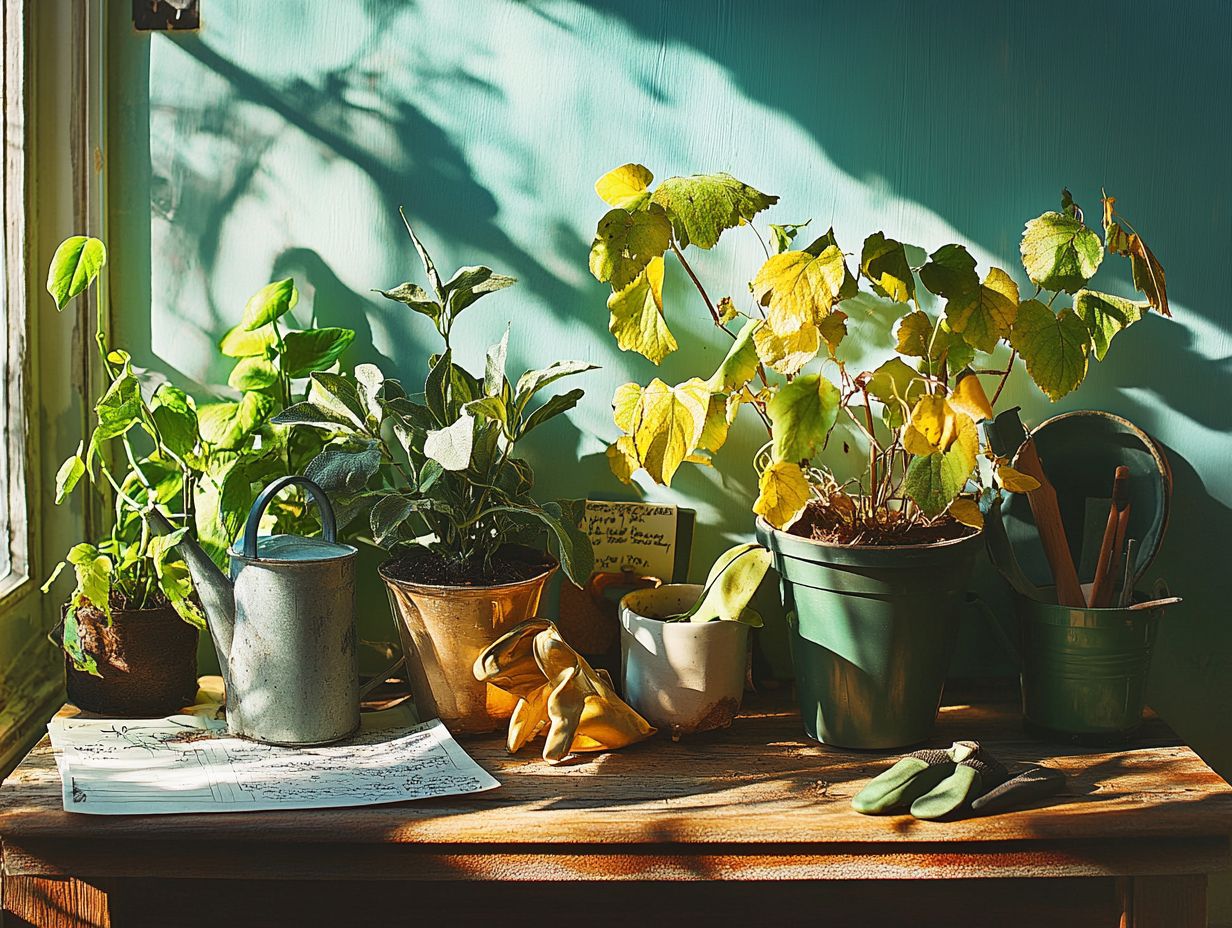
Different types of lighting for your indoor plants can profoundly impact their health and growth. Options range from natural sunlight to artificial grow lights, each tailored to the unique needs of various plant species.
Understanding the distinct characteristics of full-spectrum grow lights and fluorescent fixtures can empower you to make informed choices. Full-spectrum lights provide a balanced light spectrum that closely mimics the sun’s rays, making them ideal for supporting seedlings and promoting vigorous growth. Fluorescent lights are energy-efficient and perfect for low-light-loving plants, enabling them to thrive indoors.
Embracing natural sunlight whenever possible can enhance your plants’ vitality by providing a rich source of energy.
When selecting the appropriate lighting, consider your plants’ specific needs at different growth stages. Careful consideration ensures your plants thrive, allowing your indoor garden to flourish.
How Can One Choose the Right Soil for Their Plants?
Choosing the right soil for your indoor plants is crucial, as different soil types offer varying levels of drainage, aeration, and nutrient availability that significantly impact plant health and growth.
Understanding soil types made for specific plants can elevate your gardening experience. For example, succulents flourish in gritty, well-draining mixtures that prevent excess moisture, while tropical plants often thrive in richer, organic mixes that retain humidity without becoming waterlogged. If you encounter issues, check out these 5 easy fixes for indoor plant issues.
As you select your soil, consider your plant’s hydration needs and light conditions. Amending your chosen mix with perlite or compost can help fine-tune drainage and nutrient levels, creating an ideal environment for your leafy companions to thrive. However, be aware of common issues in plant propagation that may arise, and how to address them effectively.
What Are the Common Signs of Plant Distress?
Act quickly! Recognizing signs of plant distress is essential for you as an indoor gardener. Symptoms like yellowing leaves, distorted growth, and the unwelcome presence of insects often signal underlying issues that require your immediate attention.
Identifying these warning signs early can significantly impact your plant’s health. For instance, yellowing leaves typically indicate nutrient deficiencies or potential root issues from overwatering. Noticing leaf spots may suggest fungal infections or pest invasions, while weak growth could hint at inadequate light or competition from neighboring plants. It’s also helpful to be aware of watering myths about indoor plants to ensure proper care.
Fluctuations in temperature or humidity can exacerbate these symptoms, creating an unhealthy environment for your green companions. By understanding these factors, you can implement timely interventions, ensuring your plants flourish in a nurturing atmosphere. For those new to plant care, exploring the top 5 indoor plants for beginners can be a great starting point.
How Can One Create a Successful Plant Care Routine?
Creating a successful plant care routine starts with a deep understanding of your indoor plants specific needs, including their hydration, light, and nutrient requirements all of which work together to promote their health and longevity.
Recognizing the unique characteristics of each plant species allows you to craft a tailored schedule that incorporates regular watering, sufficient light exposure, and periodic feeding. Start by establishing a dedicated watering schedule, adjusting it according to the season. Your plants will generally thrive on more water during their active growing season in spring and summer but will need less during the dormancy of fall and winter. Additionally, be aware of common soil issues affecting indoor plants that can impact their health.
Monitoring light exposure is equally crucial; ensure your plants are positioned to receive the right amount of natural light, and adjust as the days lengthen or shorten. Regular check-ups allow you to spot signs of distress, such as yellowing leaves or stunted growth, enabling you to promptly address any nutrient imbalances. For optimal results, consider following 5 essential soil care tips for indoor plants. This proactive approach fosters a thriving indoor ecosystem that flourishes under your care.
Your Plant Care Questions Answered!
Got plant care questions? You’re not alone! Here are some common concerns and simple solutions to help your green friends thrive!
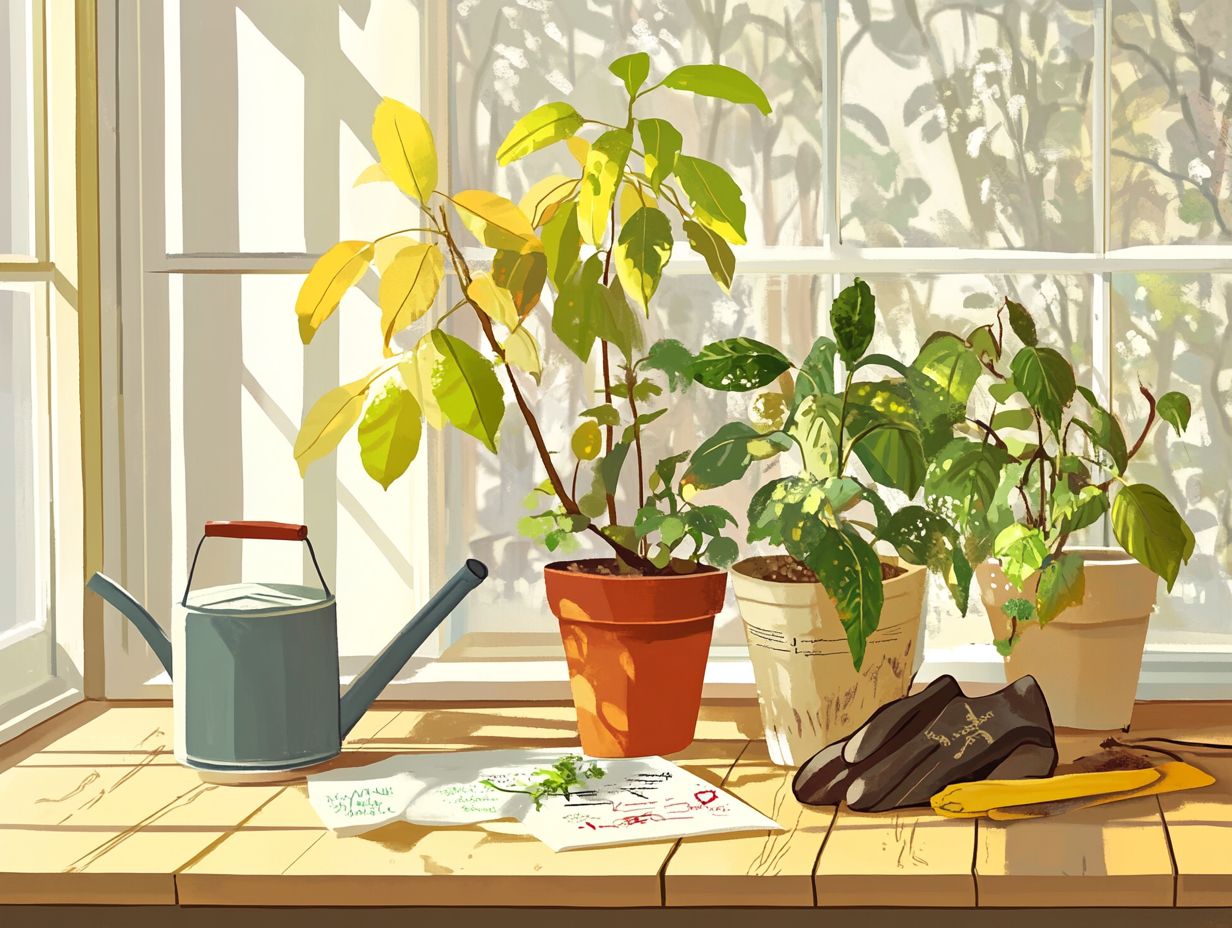
What are the 5 common issues that beginners may face in plant care?
Beginners often face five common issues in plant care. These are overwatering, underwatering, incorrect lighting, pest infestations, and improper fertilization.
How can I prevent overwatering my plants?
Check the soil moisture before watering. Water only when the top inch of soil is dry, and ensure your pot has proper drainage.
What should I do if my plant is not getting enough water?
Check the soil for dryness. Water accordingly, and consider misting the leaves or placing a tray of water nearby to increase humidity.
What types of lighting do plants need?
Plants have different lighting needs based on their species. Some require direct sunlight, while others do well in indirect or low light.
How can I get rid of pests on my plants?
You can use natural remedies like neem oil or insecticidal soap to eliminate pests. For severe infestations, apply chemical pesticides carefully.
Is fertilization necessary for plant care?
Fertilization is essential for plant growth. But avoid over-fertilizing and choose the correct type of fertilizer for your plants.

